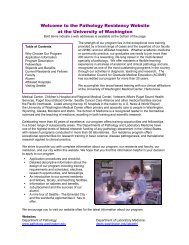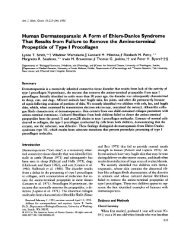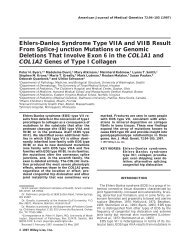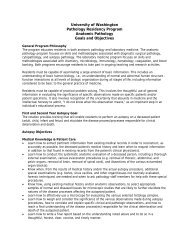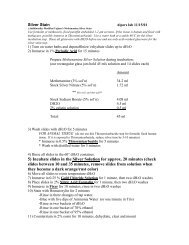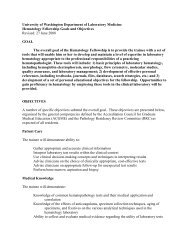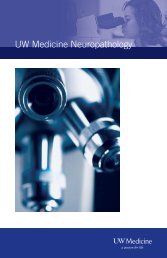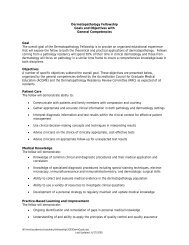Pathology Residency Program - Pathology - University of Washington
Pathology Residency Program - Pathology - University of Washington
Pathology Residency Program - Pathology - University of Washington
You also want an ePaper? Increase the reach of your titles
YUMPU automatically turns print PDFs into web optimized ePapers that Google loves.
• Electron Microscopy: Training in the use and interpretation <strong>of</strong> diagnostic electron microscopy<br />
is available in rotations <strong>of</strong> one to two months at either the VA Puget Sound Health Care System<br />
(Dr. Thorning) or at UWMC.<br />
• Flow Cytometry: Under the direction <strong>of</strong> Dr. Rabinovitch, the flow lab routinely analyzes DNA<br />
ploidy patterns <strong>of</strong> tumors from most organs using multi-parameter flow cytometry.<br />
• Forensic <strong>Pathology</strong>: The King County Medical Examiner’s Office, located in HMC, performs<br />
1,000 autopsies per year under Dr. Harruff’s direction. Training and experience in forensic<br />
pathology include scene investigation and court testimony.<br />
• Community Practice: Provides residents with a hands-on opportunity to work with pathologists<br />
at Swedish Medical Center with faculty members from CellNetix <strong>Pathology</strong>.<br />
• Research: Elective time is available at virtually any research lab at UWMC, HMC, CHRMC, Fred<br />
Hutchinson Cancer Research Center, or Seattle Cancer Care Alliance. This is a valuable<br />
opportunity for residents interested in a multi-year research fellowship to familiarize themselves<br />
with the lab, its director and personnel, and its projects.<br />
Research Opportunities<br />
Our goal is to train residents to become well-rounded<br />
academic and clinical pathologists who will practice<br />
and develop pathology into the future. To achieve this<br />
goal, we believe research training is important for all<br />
residents, whether they seek a career in academic or<br />
community pathology. We encourage residents to<br />
work with faculty members by investigating a<br />
biomedical area <strong>of</strong> interest. We support residents'<br />
research endeavors by providing travel funds for<br />
presentations at national meetings.<br />
2007 USCAP Faculty and Resident Presentations<br />
Areas <strong>of</strong> Research<br />
In 2007 for the first time the <strong>University</strong> <strong>of</strong> <strong>Washington</strong> received more than $1 billion dollars in research<br />
funding, which was for peer-reviewed research proposals for individual faculty members. The<br />
Departments <strong>of</strong> <strong>Pathology</strong> and Laboratory Medicine are consistent in the top three NIH recipients for<br />
pathology programs in the United States. For the 06-07 fiscal year, <strong>Pathology</strong> received $30,585,000 and<br />
Laboratory Medicine received $15,165,760 in overall research funding. AP/CP residents can apply for a<br />
fifth year <strong>of</strong> clinical research which can be funded by the departments through a combination <strong>of</strong><br />
departmental funds and training grants. This can also be an option for the third year <strong>of</strong> training for AP or<br />
CP only residents. If you are interested in continuing or pursuing an academic research career, you<br />
should discuss your future plans as soon as possible with your faculty advisor who will be very helpful in<br />
mentoring your career aspirations.<br />
Teaching Opportunities<br />
Residents teach medical students taking electives in Anatomic and Clinical <strong>Pathology</strong>. For the first and<br />
second year students, residents work with faculty teaching pathology laboratory sessions. For medical<br />
students on elective rotation in Anatomic <strong>Pathology</strong>, residents work directly with students on both<br />
autopsy and surgical pathology cases. Residents also work with trainees from other programs including<br />
radiology and dermatology residents. In addition, residents give lectures and assist faculty in small group<br />
-9-



